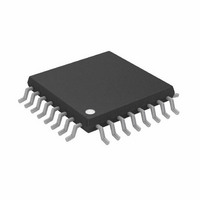AD7265BSUZ Analog Devices Inc, AD7265BSUZ Datasheet - Page 15

AD7265BSUZ
Manufacturer Part Number
AD7265BSUZ
Description
IC,Data Acquisition System,3-CHANNEL,12-BIT,TQFP,32PIN,PLASTIC
Manufacturer
Analog Devices Inc
Datasheet
1.AD7265BCPZ-REEL.pdf
(28 pages)
Specifications of AD7265BSUZ
Design Resources
AD7265 in Differential and Single-Ended Configurations Using AD8022 (CN0048)
Number Of Bits
12
Sampling Rate (per Second)
1M
Data Interface
DSP, MICROWIRE™, QSPI™, Serial, SPI™
Number Of Converters
2
Power Dissipation (max)
21mW
Voltage Supply Source
Analog and Digital
Operating Temperature
-40°C ~ 125°C
Mounting Type
Surface Mount
Package / Case
32-TQFP, 32-VQFP
Number Of Elements
2
Resolution
12Bit
Architecture
SAR
Sample Rate
1MSPS
Input Polarity
Unipolar
Input Type
Voltage
Rated Input Volt
2.5/5V
Differential Input
Yes
Power Supply Requirement
Analog and Digital
Single Supply Voltage (typ)
3/5V
Single Supply Voltage (min)
2.7V
Single Supply Voltage (max)
5.25V
Dual Supply Voltage (typ)
Not RequiredV
Dual Supply Voltage (min)
Not RequiredV
Dual Supply Voltage (max)
Not RequiredV
Power Dissipation
21mW
Differential Linearity Error
-0.99LSB/1.5LSB
Integral Nonlinearity Error
±1.5LSB
Operating Temp Range
-40C to 125C
Operating Temperature Classification
Automotive
Mounting
Surface Mount
Pin Count
32
Package Type
TQFP
Lead Free Status / RoHS Status
Lead free / RoHS Compliant
For Use With
EVAL-AD7265CB - BOARD EVALUATION FOR AD7265
Lead Free Status / Rohs Status
Compliant
Available stocks
Company
Part Number
Manufacturer
Quantity
Price
Company:
Part Number:
AD7265BSUZ
Manufacturer:
ADI
Quantity:
200
Company:
Part Number:
AD7265BSUZ
Manufacturer:
Analog Devices Inc
Quantity:
10 000
Company:
Part Number:
AD7265BSUZ-REEL
Manufacturer:
Analog Devices Inc
Quantity:
10 000
Company:
Part Number:
AD7265BSUZ-REEL7
Manufacturer:
Analog Devices Inc
Quantity:
10 000
Part Number:
AD7265BSUZ-REEL7
Manufacturer:
ADI/亚德诺
Quantity:
20 000
Differential Mode
The AD7265 can have a total of six differential analog
input pairs.
Differential signals have some benefits over single-ended
signals, including noise immunity based on the device’s
common-mode rejection and improvements in distortion
performance. Figure 23 defines the fully differential analog
input of the AD7265.
The amplitude of the differential signal is the difference
between the signals applied to the V
differential pair (V
simultaneously driven by two signals each of amplitude V
2 × V
phase. The amplitude of the differential signal is therefore
(assuming the 0 to V
to-peak (2 × V
The common mode is the average of the two signals
and is therefore the voltage on which the two inputs are
centered.
This results in the span of each input being CM ± V
voltage has to be set up externally, and its range varies with the
reference value, V
mode range decreases. When driving the inputs with an amplifier,
the actual common-mode range is determined by the amplifier’s
output voltage swing.
Figure 24 and Figure 25 show how the common-mode range
typically varies with V
V
must be in this range to guarantee the functionality of the AD7265.
When a conversion takes place, the common mode is rejected,
resulting in a virtually noise-free signal of amplitude −V
+V
2 × V
from −2 V
REF
REF
(V
range or 2 × V
REF
REF
corresponding to the digital codes of 0 to 4096. If the
IN+
, depending on the range chosen) that are 180° out of
range is used, then the input signal amplitude extends
COMMON
VOLTAGE
+ V
REF
MODE
to +2 V
IN−
REF
Figure 23. Differential Input Definition
)/2
), regardless of the common mode (CM).
REF
1
ADDITIONAL PINS OMITTED FOR CLARITY.
IN+
REF
. As the value of V
REF
REF
− V
REF
range, respectively. The common mode
range is selected) −V
after conversion.
V
V
for a 5 V power supply using the 0 to
IN−
REF
REF
). V
p-p
p-p
IN+
and V
V
V
IN+
AD7265
IN+
IN–
REF
and V
increases, the common-
IN−
1
should be
REF
IN−
to +V
pins in each
REF
REF
/2. This
REF
peak-
REF
to
Rev. A | Page 15 of 28
(or
Driving Differential Inputs
Differential operation requires that V
simultaneously driven with two equal signals that are 180° out
of phase. The common mode must be set up externally. The
common-mode range is determined by V
and the particular amplifier used to drive the analog inputs.
Differential modes of operation with either an ac or dc input
provide the best THD performance over a wide frequency
range. Because not all applications have a signal preconditioned
for differential operation, there is often a need to perform
single-ended-to-differential conversion.
Figure 24. Input Common-Mode Range vs. V
Figure 25. Input Common-Mode Range vs. V
5.0
4.5
4.0
3.5
3.0
2.5
2.0
1.5
1.0
0.5
3.5
3.0
2.5
2.0
1.5
1.0
0.5
0
0
0
0
T
T
A
A
= 25°C
= 25°C
0.5
0.5
1.0
1.5
1.0
2.0
V
V
REF
REF
2.5
(V)
(V)
1.5
3.0
IN+
REF
REF
3.5
and V
(0 to V
(2 × V
REF
, the power supply,
2.0
4.0
REF
REF
IN−
Range, V
Range, V
be
4.5
AD7265
2.5
5.0
DD
DD
= 5 V)
= 5 V)
















